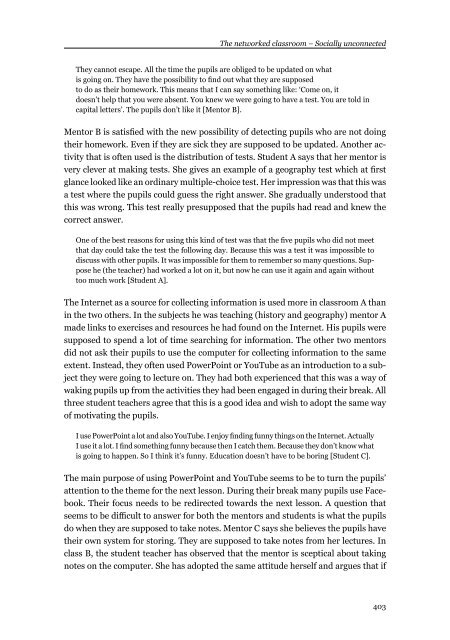Download issue - Umeå universitet
Download issue - Umeå universitet
Download issue - Umeå universitet
Create successful ePaper yourself
Turn your PDF publications into a flip-book with our unique Google optimized e-Paper software.
The networked classroom – Socially unconnected<br />
They cannot escape. All the time the pupils are obliged to be updated on what<br />
is going on. They have the possibility to find out what they are supposed<br />
to do as their homework. This means that I can say something like: ‘Come on, it<br />
doesn’t help that you were absent. You knew we were going to have a test. You are told in<br />
capital letters’. The pupils don’t like it [Mentor B].<br />
Mentor B is satisfied with the new possibility of detecting pupils who are not doing<br />
their homework. Even if they are sick they are supposed to be updated. Another activity<br />
that is often used is the distribution of tests. Student A says that her mentor is<br />
very clever at making tests. She gives an example of a geography test which at first<br />
glance looked like an ordinary multiple-choice test. Her impression was that this was<br />
a test where the pupils could guess the right answer. She gradually understood that<br />
this was wrong. This test really presupposed that the pupils had read and knew the<br />
correct answer.<br />
One of the best reasons for using this kind of test was that the five pupils who did not meet<br />
that day could take the test the following day. Because this was a test it was impossible to<br />
discuss with other pupils. It was impossible for them to remember so many questions. Suppose<br />
he (the teacher) had worked a lot on it, but now he can use it again and again without<br />
too much work [Student A].<br />
The Internet as a source for collecting information is used more in classroom A than<br />
in the two others. In the subjects he was teaching (history and geography) mentor A<br />
made links to exercises and resources he had found on the Internet. His pupils were<br />
supposed to spend a lot of time searching for information. The other two mentors<br />
did not ask their pupils to use the computer for collecting information to the same<br />
extent. Instead, they often used PowerPoint or YouTube as an introduction to a subject<br />
they were going to lecture on. They had both experienced that this was a way of<br />
waking pupils up from the activities they had been engaged in during their break. All<br />
three student teachers agree that this is a good idea and wish to adopt the same way<br />
of motivating the pupils.<br />
I use PowerPoint a lot and also YouTube. I enjoy finding funny things on the Internet. Actually<br />
I use it a lot. I find something funny because then I catch them. Because they don’t know what<br />
is going to happen. So I think it’s funny. Education doesn’t have to be boring [Student C].<br />
The main purpose of using PowerPoint and YouTube seems to be to turn the pupils’<br />
attention to the theme for the next lesson. During their break many pupils use Facebook.<br />
Their focus needs to be redirected towards the next lesson. A question that<br />
seems to be difficult to answer for both the mentors and students is what the pupils<br />
do when they are supposed to take notes. Mentor C says she believes the pupils have<br />
their own system for storing. They are supposed to take notes from her lectures. In<br />
class B, the student teacher has observed that the mentor is sceptical about taking<br />
notes on the computer. She has adopted the same attitude herself and argues that if<br />
403

















